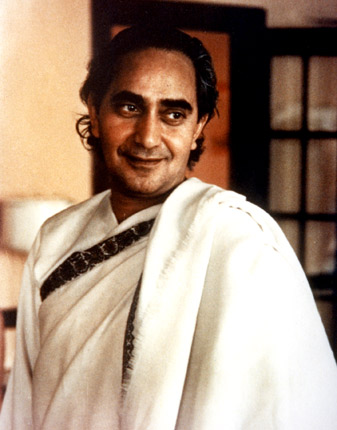A Brief Introduction to Raja Yoga
by Shri Swami Rama of the Himalayas

“There are seven schools of Indian philosophy, ranging from extreme materialism, where nothing but matter fills the universe, to extreme spiritualism, where matter is a mere shadow of spirit. The Samkhya and Yoga schools are midway between these. Interestingly, these two are complementary: the Yoga school deals with the practical steps of achieving liberation from all human imperfections and suffering, while the Samkhya school provides the philosophical doctrines within which the existence of these imperfections and suffering are to be understood.
“The Samkhya school was founded by the sage Kapila around 600 BCE and admits of two realities: Purusha, or Ultimate Consciousness. and Prakrti, or Elemental Matter. The manifest universe is an evolution of Prakrti resulting from the melding of Purusha and Prakrti, that is, Matter being permeated by Consciousness. This evolution occurs both in the macrocosm — the universe as a whole — and the microcosm — mankind. Yoga bases its teachings on this evolution of mankind. It concerns itself with the practical aspects not of reversing this evolution but instead of bringing about an involution: how mankind can be led by an inner path from manifest body and mind to Ultimate Consciousness.
“The principal teaching of Yoga is that mankind’s True Nature is Divine. Man is unaware of this True Nature and, instead, falsely identifies with his body and his intellect - both of which are comprised of Prakrti and hence are subject to death and decay. All of mankind’s misery is therefore a consequence of this false identification. Yoga leads to realization of the True Self, and with such realization comes liberation from all human imperfection.
There are many paths to realization of the True Self, just as there are many spokes from the rim of a wheel to its center. “Yoga” is used here in a generic sense for all of these different paths, of which the four principal are
- Karma Yoga — the yoga of action
- Bhakti Yoga — the yoga of devotion
- Jnana Yoga — the yoga of knowledge or discrimination
- Raja Yoga — the Royal Path
“Raja Yoga encompasses the teachings of all the different paths. Raja Yoga concerns itself with three dimensions or realms: the physical, the mental and the spiritual. Through practicing Raja Yoga methods, one achieves mastery of all three realms and is thus led to the full realization of the Self.
“The teachings of Raja Yoga go back many thousands of years, and little is known of their origin. They are considered to be Revealed Teachings of Divine Origin. The sage Patanjali, who lived somewhere between 200 BCE and the 4th century CE, systemized and codified these teachings into 196 Sutras or aphorisms which were made as brief as possible to facilitate their memorization and oral transmission. The first commentaries on the Sutras date from the 4th century CE.
“Patanjali’s “Yoga Sutras” are organized into four padas or chapters. The first deals with Samadhi, the blissful state of Self-realization; the second with the practical means of achieving this goal; the third with the Siddhis, or powers, that manifest in the successful practitioner of Raja Yoga; and the last with Kaivalya, or liberation. It is the practical means of achieving Samadhi through Raja Yoga that is called Astanga_Yoga, the Eight-fold (or Eight-limbed) Path.
“The eight angas, or limbs, are Yama, Niyama, Asana, Pranayama, Pratyahara, Dhrana, Dhyana and Samadhi. The first five of these limbs are considered the “external” limbs; the last three, “internal”. We will consider each of these briefly.
“The Yamas, or prescriptions (“what you should do”), and the Niyamas, or proscriptions (“what you should not do”), constitute the moral code of Yoga and help one cultivate the right mental attitudes.
“The Asanas, or postures, aim at physical well-being and control over the body. A healthy body is a prerequisite for a healthy and controlled mind.
“Pranayama is control of Prana, or the Life Force. Such control is achieved through control of the most crude manifestation of Prana: the breath. One can control the mind only if s/he can control her/his breathing.
“Pratyahara is withdrawal of the senses and is necessary if one is to achieve tranquility of the mind.
“Dhrana is attention and concentration which brings the diffuse mind to a single point of focus. Prolonged Dhrana leads to a state of . . .
“Dhyana, or meditation, characterized by a one-pointedness of mind. Prolonged Dhyana leads to . . .”Samadhi, the state of Self-realization. The mind is transcended, and one becomes aware of the Self and is united with It.
This state is characterized by Sat-Chit-Ananda, or Existence-Consciousness-Bliss: one has merged with Ultimate Consciousness which is Ultimate Reality.
“Raja Yoga is, therefore, a systematic and scientific discipline that leads to Ultimate Truth. Most religions teach one what to do, but Raja Yoga teaches one how to be. Unlike most religions, it does not require unquestioning faith. Instead it encourages healthy discrimination leading to liberation.
“By following the path prescribed by Raja Yoga, one can verify for himself its central hypothesis that mankind’s True Nature is Divine. It is not merely an ancient, esoteric philosophy but also a practical, systematic and scientific quest for the Infinite which is relevant and necessary in our modern times, both in the East and the West. If incorporated into modern education, it would equip mankind to deal with the conflicts, frustrations and turmoil which seem inevitable in all modern societies. Through Raja Yoga, mankind can realize its full potential for creative thought and action, transcending all human limitations and realizing its True Nature.”




